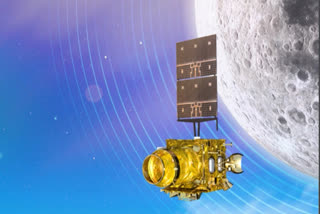Chennai: Indian space agency has released a fresh set of pictures of impact craters on moon surface taken by its Chandrayaan-2 Orbiter.
The Indian Space Research Organisation (ISRO) on Tuesday released a picture on its Twitter handle and said the images were taken by the Dual Frequency-Synthetic Aperture Radar (DF-SAR) on its Chandrayaan-2 Orbiter.
According to ISRO, the Moon has been continuously bombarded by meteorites, asteroids and comets since its formation. This has resulted in the formation of innumerable impact craters that form the most distinct geographic features on its surface.
Impact craters are approximately circular depressions on the surface of the moon, ranging from small, simple, bowl-shaped depressions to large, complex, multi-ringed impact basins.
"In contrast to volcanic craters, which result from explosion or internal collapse, impact craters typically have raised rims and floors that are lower in elevation than the surrounding terrain," ISRO said.
The study of the nature, size, distribution and composition of impact craters and associated ejecta (material that gets thrown out on an impact) features reveal valuable information about the origin and evolution of craters.
According to ISRO, weathering processes result in many of the crater physical features and ejecta material gets covered by layers of regolith (sand, dust, loose rock and soil over a hard surface) making some of them undetectable using optical cameras.
The Indian space agency said the SAR is a powerful remote sensing instrument for studying planetary surfaces and subsurface due to the ability of the radar signal to penetrate the surface. It is also sensitive to the roughness, structure and composition of the surface material and the buried terrain.
Previous lunar-orbiting SAR systems such as the S-band hybrid-polarimetric SAR on ISRO's Chandrayaan-1 and the S & X-band hybrid-polarimetric SAR on NASA's LRO, provided valuable data on the scattering characterisation of ejecta materials of lunar impact craters, ISRO said.
However, L & S-band SAR on Chandraayan-2 is designed to produce greater details about the morphology and ejecta materials of impact craters due to its ability of imaging with higher resolution (2 - 75m slant range) and full-polarimetric modes in standalone as well as joint modes in S and L-band with wide range of incidence angle coverage (9.5 degrees - 35 degrees).
